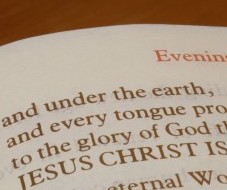Today’s celebration reminds us that Lent has been taking us somewhere, and now we see where that somewhere is: Calvary. These days have led us to the cross, which is a place to which, quite frankly, few of us ever want to go. The Psalmist today captures the feeling of our hearts as we arrive here at the cross: “My God, my God, why have you abandoned me?”
And haven’t we all asked that question at least once in our lives? As we sing those words, they can quite frankly bring back painful memories, whether they be memories of past hurts, or reflections of current ones. Maybe it’s the time when you were sexually abused and felt abandoned because you were convinced no one would believe you. Maybe it’s the time you received a frightening diagnosis and you felt abandoned because you couldn’t enter into daily life with the same carefree attitude you previously had. Maybe it’s the occasion of the death of a loved one and you felt abandoned because everyone on the planet seemed joyful, except you. Maybe it’s the time you were laid off from your job and you felt abandoned because it seemed that no one valued your skills and talents.
And so we pray with the Psalmist, with Jesus, and with every person who has ever felt lost and alone: “My God, my God, why have you abandoned me?” It’s natural that we would prefer to avoid the cross. It’s painful, it’s embarrassing, and it ultimately alienates us from the world. But, the cross is what joins us to Christ. Christ did not shun the cross on the way to accomplish his mission. He took up that cross, died on it, taking with it all of our pain, all of our shame, all of our loneliness, all of our abandonment, all of our sin, and most of all, our death.
Without the cross, there is no resurrection. Not for Jesus, and so also, not for us. Jesus certainly had his moment in the Garden of Gethsemane when the knowledge of his impending death filled him with dread; so it will be for us, countless times when we are called on to take up the cross. But as we enter this Holy Week, we are reminded gently that the cross, while significant, is not the end of the story. There will be a resurrection for Jesus, and so also a resurrection for all those who believe in him, have faith in him, and follow him. And that is what gives us all the confidence to take up our cross and journey on.
I invite you all to enter into these Holy Days with passion, with prayerfulness and in faith. Gather with us on Holy Thursday evening to celebrate the giving of the Eucharist and the Priesthood, and the call to service that comes from our baptism. On Good Friday afternoon and evening, we will have the opportunity once again to reflect on the Passion, to venerate the cross that won our salvation, and to receive the Eucharist, which is our strength. Finally, on the evening of Holy Saturday, we will gather to keep vigil for the resurrection we have been promised. We will hear stories of our salvation, we will celebrate our baptism as we welcome new members to our family, seeing them fully initiated into the life of the Church, rejoicing with them in the victory of Christ over sin and death. No Catholic should miss the celebrations of these Holy Days, for these days truly sustain our daily living and give us the grace to take up our little crosses day by day.

 Chicago priest and theologian Robert Barron speaks of what he calls a “beige” Catholicism. This is how he describes the Church during the years following the second Vatican Council. It was a time, he says, when “Christianity’s distinctive qualities and bright colors tended to be muted and its rough edges smoothed, while points of contact and continuity with non-Christian and secular realms were consistently brought into the light and celebrated.” Now, to be fair, Vatican II did indeed rightly bring to light the points of contact we have with our protestant brothers and sisters, and even our non-Christian friends. We do, in fact, have some things in common. But the downside of this emphasis was this kind of “beige” or blasé religion which challenged no one. “As a result,” Barron says, “the Christianity into which I was initiated was relatively bland and domesticated, easy to grasp and unthreatening.
Chicago priest and theologian Robert Barron speaks of what he calls a “beige” Catholicism. This is how he describes the Church during the years following the second Vatican Council. It was a time, he says, when “Christianity’s distinctive qualities and bright colors tended to be muted and its rough edges smoothed, while points of contact and continuity with non-Christian and secular realms were consistently brought into the light and celebrated.” Now, to be fair, Vatican II did indeed rightly bring to light the points of contact we have with our protestant brothers and sisters, and even our non-Christian friends. We do, in fact, have some things in common. But the downside of this emphasis was this kind of “beige” or blasé religion which challenged no one. “As a result,” Barron says, “the Christianity into which I was initiated was relatively bland and domesticated, easy to grasp and unthreatening.
You must be logged in to post a comment.